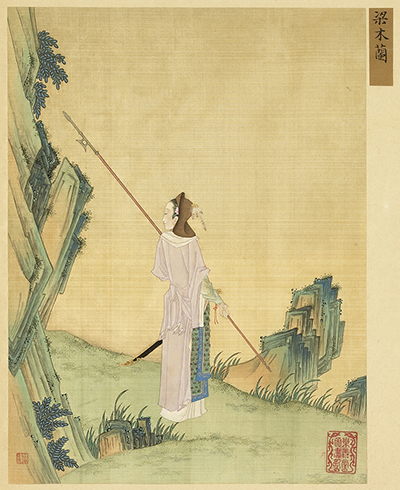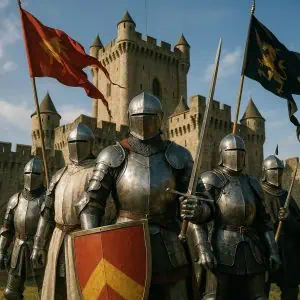While knighthood was traditionally a male domain, history reveals a number of female knights who defied social norms and demonstrated remarkable courage and skill. These women, whether officially knighted or recognized through battlefield valor, challenged the limitations placed on them by medieval society. Figures like Joan of Arc and members of military orders such as the Order of the Hatchet showed that women could embody the same ideals of chivalry, honor, and martial prowess as their male counterparts. Their stories reflect both the rarity and the impact of women in knightly roles throughout the Middle Ages.

“Female knights were rare, but they did exist. These women were exceptional, both in terms of their physical prowess and their social standing, and they played a significant role in shaping the chivalric culture of medieval Europe.”
Sarah Gristwood, historian and author of “Blood Sisters: The Hidden Lives of Women Behind the Wars of the Roses”.
This code was closely associated with the idea of male knights, but what about the role of women in chivalry?
Were there any female knights, and if so, what was their role?
The idea of female knights is not something that is often discussed in popular culture or history books. This is partly due to the fact that the majority of knights were male, and therefore the history of chivalry is predominantly focused on their actions and achievements.
However, this does not mean that women did not play a role in chivalry, and in fact, there were some notable examples of female knights who made significant contributions to the code of chivalry.

Women & Chivalry – Joan of Arc
One of the earliest examples of a female knight was Joan of Arc. Born in 1412, Joan was a peasant girl from France who became a military leader during the Hundred Years’ War.
She claimed to have received visions from saints, which led her to believe that she was called by God to help the French in their war against the English.

She dressed in men’s clothing and led French troops into battle, where she demonstrated great bravery and military skill. In 1429, she helped to lift the English siege of Orleans, which was a turning point in the war.

“The idea that women could participate in the chivalric tradition was not entirely unheard of in the Middle Ages. There are several accounts of women who dressed as knights and fought alongside men in battle, although such cases were undoubtedly exceptional.”
Kelly DeVries, historian and author of “Joan of Arc: A Military Leader”.
Although she was eventually captured by the English and burned at the stake for heresy, Joan of Arc’s bravery and leadership qualities made her a symbol of French national pride and an inspiration to many.
Women & Chivalry – Mulan
Another example of a female knight was the legendary figure of Mulan. Although she is often thought of as a fictional character, Mulan was actually based on a real historical figure from China.
According to legend, Mulan disguised herself as a man and joined the army in place of her father, who was too old to fight. She served for over a decade and was eventually honored by the emperor for her bravery and military prowess.
Although the story of Mulan has been romanticized over the years, it is clear that the real-life woman who inspired the legend was a highly skilled and respected warrior.

“The fact that women were excluded from the formal structures of knighthood did not mean that they were excluded from the chivalric culture that surrounded it. Women played an important role in shaping the ideals of chivalry, both through their influence over the knights themselves and through their own embodiment of chivalric virtues.”
Caroline Walker Bynum, historian and author of “Holy Feast and Holy Fast: The Religious Significance of Food to Medieval Women”.
Women Warriors Margaret of Anjou & Caterina Sforza
In addition to these famous examples, there were also other women who took up arms and fought alongside men in battles during the medieval period. While they may not have been officially recognized as knights, their actions were no less courageous or significant.

Women such as Margaret of Anjou, who led her troops in the Wars of the Roses, and Caterina Sforza, who defended her castle against attackers in the 15th century, were both examples of women who defied societal expectations and showed themselves to be capable leaders and fighters.
However, it is important to note that the role of women in chivalry was not limited to military action. Women also played a key role in upholding the virtues of the chivalric code through their behavior and relationships with men.

“While it is true that most women in the Middle Ages were relegated to domestic roles, there were some who were able to transcend these limitations and make a name for themselves as warriors and leaders. These women defied conventional gender norms and paved the way for future generations of women to follow in their footsteps.”
Judith Bennett, historian and author of “Ale, Beer, and Brewsters in England: Women’s Work in a Changing World”.
Noblewomen were expected to be paragons of virtue, embodying qualities such as modesty, piety, and loyalty. They were also expected to be skilled in the arts of conversation and entertainment, as well as being knowledgeable about politics and diplomacy.
Women such as Eleanor of Aquitaine, who was queen of France and later England in the 12th century, were known for their political acumen and played a significant role in shaping the political landscape of their time.

Conclusion
In conclusion, the role of women in chivalry is often overlooked, but it is clear that they did play a role in upholding the virtues of the chivalric code. While there were some notable examples of female knights, the majority of women who participated in chivalry did so through their behavior and relationships with men

“The history of female knights and women in chivalry is a testament to the resilience and resourcefulness of women throughout history. Despite facing significant barriers to participation in the chivalric culture of their time, these women were able to carve out a space for themselves and make meaningful contributions to the world around them.”
Dan Jones, historian and author of “The Plantagenets: The Warrior Kings and Queens Who Made England”.
5 Great Books about Female Knights
“Blood Sisters: The Hidden Lives of Women Behind the Wars of the Roses” by Sarah Gristwood.
This book explores the role of women in the Wars of the Roses, including several female knights who fought alongside their male counterparts.
“Joan of Arc: A Military Leader” by Kelly DeVries.
This book examines Joan of Arc’s military leadership and her role in the Hundred Years’ War, including her adoption of male dress and her participation in battles.
“Holy Feast and Holy Fast: The Religious Significance of Food to Medieval Women” by Caroline Walker Bynum.
Although not specifically focused on female knights, this book provides a fascinating look at the role of women in medieval society and their contributions to the culture of chivalry.
“Ale, Beer, and Brewsters in England: Women’s Work in a Changing World” by Judith M. Bennett.
This book explores the role of women in brewing and other trades in medieval England, highlighting the ways in which women were able to challenge traditional gender roles and assert their independence.
“The Knight’s Tale: Alisoun’s Story” by Catherine M. Jones.
This novel tells the story of Alisoun, a female knight who travels to Jerusalem to fight in the Crusades. The book provides an engaging fictionalized account of the experiences of a woman in a traditionally male-dominated field.
Frequently Asked Questions About Female Knights in History
Were there really female knights in history?
Yes, although rare, some women were knighted for exceptional bravery or service, often participating in battles or defending territories.
Who was one of the most famous female knights?
Joan of Arc is the most well-known female warrior who led troops during the Hundred Years’ War and was later canonized as a saint.
Did female knights follow the code of chivalry?
Yes, female knights upheld the principles of honor, courage, and loyalty, just like their male counterparts.
Were female knights allowed to participate in tournaments?
Participation in tournaments was uncommon, but some exceptional women did take part in ceremonial or combat demonstrations.
How were women trained to become knights?
Training for female knights included combat skills, horsemanship, and strategy, often under the guidance of experienced warriors or family members.
Did female knights hold land or titles?
Some female knights were granted lands or noble titles for their service, though this was much less common than for men.
Were female knights recognized by their peers?
Recognition was limited, but courageous women who fought and led troops were respected and sometimes celebrated in historical records.
Did religion play a role for female knights?
Yes, many female knights were deeply religious, often praying for guidance, protection, and success in their missions.
Were there female knights outside Europe?
While European records are most common, women warriors existed in other cultures, though they may not have been formally knighted.
What legacy did female knights leave?
Female knights inspired generations of women, proving that courage, skill, and honor were not limited by gender.






